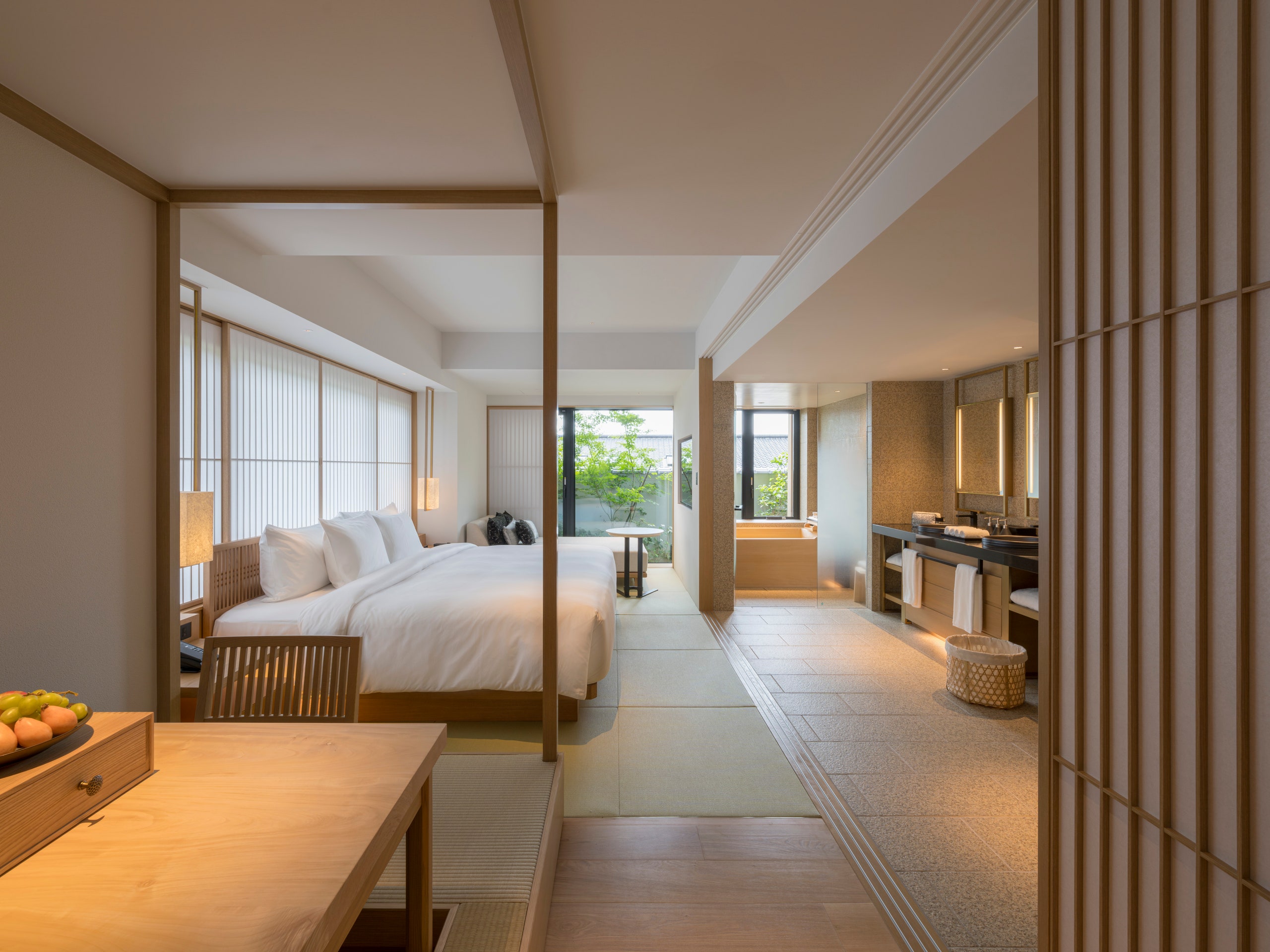Products are independently selected by our editors. We may earn an affiliate commission from links.
As Japan’s ancient capital, Kyoto’s rich history has long attracted visitors in droves—but it was only in recent years that the city’s luxury hotel scene really came into its own, due to an exponential influx of international and boutique brands. The latest addition to the city, that will begin welcoming guests this Friday? Banyan Tree Higashiyama Kyoto.
Nestled in the hills of Higashiyama Ward, the hotel is set on the grounds of the former Hotel Ryozen in a location that strikes a balance between remoteness and convenience. Surrounded by lush trees and its own little bamboo grove (who needs Arashiyama and its ensuing crowds), the hotel is just removed enough that guests can enjoy Kyoto’s natural beauty without all the hustle and bustle. Yet it’s simultaneously a stone’s throw away from some of the city’s most popular attractions, like the picturesque Yasaka Pagoda; Ninenzaka and Sannenzaka, a pair of pedestrian-only, shop-lined streets; and Kiyomizu-dera, a Buddhist temple dating back more than a millennium that has been dubbed a UNESCO World Heritage Site.
Given the historic setting, it’s appropriate that the brand’s first foray in the country is an homage to classic Japanese design with interiors reminiscent of a ryokan, punctuated by modern touches befitting of present-day travelers. So it comes as no surprise that Kengo Kuma was tapped for the project, whose philosophy of harmoniously integrating buildings into its surrounding environment and making natural materials the star serves as the perfect fit. In the case of Banyan Tree Higashiyama Kyoto, its traditional architecture seamlessly blends in with nearby structures while a geometric lattice of wood beams that makes up the eaves of the entrance gives way to Kuma’s contemporary signature.
Kuma and his team were also responsible for the construction of the Noh stage, the first of its kind for any hotel in Kyoto. Originating in the 14th century, Noh is considered to be one of the world’s oldest surviving forms of theater and plays a significant role in influencing Japanese performance arts, including the ever-popular Kabuki. Although lesser known, the preservation of the centuries-old tradition is vital, and Banyan Tree aims to offer its guests an immersive experience beyond the frequently requested geiko and maiko performances (although you can expect those, too).
In addition to enjoying occasional performances, the hotel can also arrange visits to Mitsue Nakamura’s studio, where guests will have the opportunity to meet the respected Noh mask maker who has encouraged more women to practice the craft and try their hand at creating one themselves. The property will also offer a wealth of additional activities that highlight Kyoto’s culture, such as traditional tea ceremonies, hands-on workshops with pottery, and kimono weaving led by local artisans. Guests are also encouraged to participate in the tradition of onsen bathing. One of the few properties in the Higashiyama Ward to have its own hot spring source, the indoor-outdoor facility adheres to conventional Japanese customs—gender-separated, birthday suit only—and a stone-clad look that you’d expect from a classic onsen, too, complete with shower stations. The accompanying gym and spa—complete with six treatment rooms with hot spring-fed tubs, a sauna, steam room, and relaxation area—creates a wellness area that spans just over 5,800 square feet. A selection of Banyan Tree’s signature treatments will be available, like the beloved Royal Banyan massage, along with Kyoto-exclusive therapies like a bamboo massage and packages that include private en-suite onsen time.
In the 52 rooms, you’ll find a continuation of a neutral color palette, natural materials, and minimalist approach to décor. Archetypal elements like shoji screens, tatami mats, and low-profile furnishings (including horigotatsu in some accommodations) are omnipresent while the traditional technique of naguri carving is modernized by the addition of gold leaf. All the accommodations boast a Hiba wood tub while those in the eight Onsen Retreats also offer free-flowing hot spring water, joining the growing trend of hotels with a private onsen experience. Rooms will also be stocked with a set of onsen baskets, relaxation wear, and geta sandals that can be worn to the public bath.
Rounding out the entire experience is Ryozen, the property’s signature Japanese restaurant. With a focus on seasonal and local ingredients, multicourse kaiseki meals will take center stage for the time being, with plans to expand menu offerings later on. The sake-centric bar—which doubles as an afternoon tea spot by day—will surely be a favorite, however, featuring around 30 bottles of the rice spirit, the majority of which are made in Kyoto. To that, we say: kanpai!

